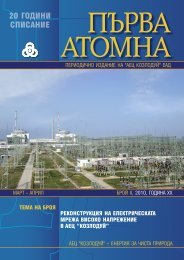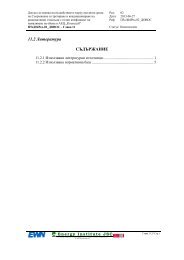Summary Report for Conduct of Kozloduy NPP Stress Tests
Summary Report for Conduct of Kozloduy NPP Stress Tests
Summary Report for Conduct of Kozloduy NPP Stress Tests
You also want an ePaper? Increase the reach of your titles
YUMPU automatically turns print PDFs into web optimized ePapers that Google loves.
“<strong>Kozloduy</strong> <strong>NPP</strong>” PLC<br />
SUMMARY REPORT<br />
<strong>for</strong> <strong>Conduct</strong> <strong>of</strong> <strong>Kozloduy</strong> <strong>NPP</strong><br />
<strong>Stress</strong> <strong>Tests</strong><br />
facilities are: a temperature between 0ºC to -4ºC, wind speed between 0 and 3 to 5 m/s and relative<br />
humidity along Danube River between 95 and 100%.<br />
With data from meteorological monitoring system in the last four years a combination <strong>of</strong><br />
such conditions was not observed in the region <strong>of</strong> <strong>Kozloduy</strong>, which is mainly due to lower levels <strong>of</strong><br />
humidity. The risk <strong>of</strong> icing conditions on the basis <strong>of</strong> the last 11 years has averaged 2% annually.<br />
This means that freezing is relatively rare.<br />
4.1.3 Extreme precipitations<br />
The annual rainfall in the region is about 518-558 mm and is one <strong>of</strong> the lowest in the<br />
country, due to rainfall "shadow" <strong>of</strong> the Southern Carpathians in the ocean incursions from the<br />
west. It is unevenly distributed throughout the year. In autumn rainfall is about 130 mm, which<br />
represents 23-25% <strong>of</strong> the annual amount. In winter rainfall is about 110-120 mm (20-23%), in the<br />
spring - 135-150 mm (24-29%), and in summer 145-150 mm (26-29%) [7], [8].<br />
In some years a number <strong>of</strong> days with precipitation can reach 4-5 days. Heavy rains with high<br />
intensity are <strong>of</strong> short duration. Maximum 24 hours <strong>for</strong> <strong>Kozloduy</strong> are 86 ÷ 87 mm [7], [8].<br />
4.1.4 Lightning<br />
ZEUS lightning recording system has been in operation <strong>for</strong> several years and the data it<br />
receives <strong>for</strong> the field with coordinates 0 – 32 0 Е and 31 – 46 0 N which includes the territory <strong>of</strong><br />
Bulgaria shows that the number <strong>of</strong> recorded lightning over land is more significant from April to<br />
September as compared to the other months <strong>of</strong> the year. For <strong>Kozloduy</strong> territory within a radius <strong>of</strong><br />
about 50 km <strong>for</strong> the summer months June, July and August <strong>of</strong> 2005 and 2006 around 3000-4000<br />
lightning were recorded. Considering that the average three-month period in the world is over 5000,<br />
it can be estimated that the number <strong>of</strong> lightning in the area <strong>of</strong> <strong>Kozloduy</strong> <strong>NPP</strong> is below average<br />
statistical values [140].<br />
4.1.5 Extreme snowfalls<br />
Snow in the region is volatile and with relatively shallow depth due to the fact that stable<br />
snow cover is typical <strong>of</strong> regions with average January temperatures below -3 º C. There is no<br />
characteristic period <strong>of</strong> the calendar year in which snow cover is regularly <strong>for</strong>med [139].<br />
The average annual snow cover height does not exceed 20 cm. Of the greatest recurrence <strong>of</strong><br />
24-30% is the height <strong>of</strong> 11-20 cm. Considered in decades, in winter months snow cover height <strong>for</strong><br />
not more than 3-4 days is about 5 cm. This allows <strong>for</strong> excluding the possibility <strong>for</strong> the water<br />
reserves in the snow cover in the region <strong>of</strong> <strong>Kozloduy</strong> to be involved in possible flooding even<br />
during sudden warming [139].<br />
Height <strong>of</strong> snow cover <strong>of</strong> 70-80 cm has a low recurrence - only 3% (1 to 2 days, based on the<br />
past data <strong>for</strong> 1977). This value is considered extreme.<br />
125/202

















